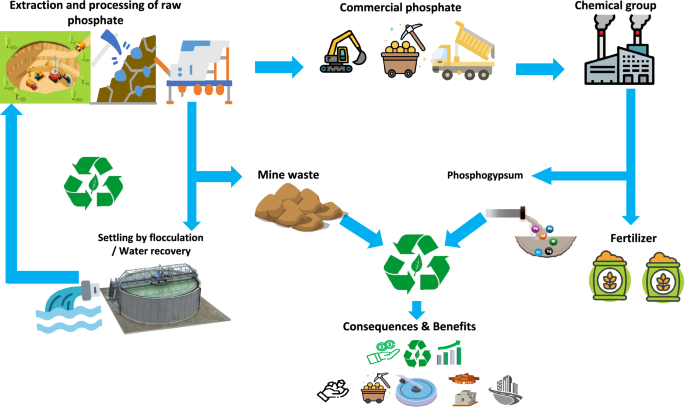Sustainable Chemistry: Reducing Waste in Phosphate Processing
Phosphate processing is a double-edged sword. On one hand, it's vital for global agriculture, fueling the production of fertilizers that help feed the world. On the other, it generates significant environmental waste, from toxic byproducts to excessive water and energy use. This contradiction puts the spotlight on a critical question: how can we maintain the benefits of phosphate production while minimizing its environmental cost?
The answer lies in sustainable chemistry in phosphate processing. By rethinking raw material usage, recycling waste streams, and adopting cleaner technologies, the industry can reduce its ecological footprint without compromising efficiency. In this blog post, we’ll explore the challenges associated with phosphate waste, highlight innovative approaches to sustainable processing and discuss the broader role of green chemistry in industrial sectors.
The Environmental Challenges of Phosphate Processing
What Is Phosphate Processing?
Phosphate processing begins with the mining of phosphate rock, a naturally occurring mineral rich in phosphorus, an essential nutrient for plant growth. Once extracted, the rock undergoes beneficiation, a series of mechanical and chemical treatments that separate the usable phosphate from unwanted materials like clay, sand and silicates. This typically involves crushing, washing, flotation and sometimes chemical reagents to improve yield. The refined phosphate is then converted through acidulation - usually with sulfuric or phosphoric acid - into various forms such as phosphoric acid or phosphate fertilizer. While essential for agricultural productivity, this process is resource-intensive and generates significant waste, posing a number of environmental risks.
Waste Streams and Their Impacts
The most prominent waste byproduct of phosphate processing is phosphogypsum, a radioactive, acidic byproduct formed during the production of phosphoric acid. Stored in large stacks, phosphogypsum can leach into soil and groundwater, threatening ecosystems and human health. Tailings from beneficiation - residual materials after phosphate extraction - often contain fine particles and heavy metals, contributing to land degradation and water contamination if not properly managed.
Another critical issue is water pollution. Phosphate processing consumes large volumes of water, and wastewater often contains fluoride, cadmium and excess phosphorus, which can lead to eutrophication in nearby water bodies. In addition, the use of fossil fuels during mining and processing results in considerable greenhouse gas emissions, further contributing to climate change.
Addressing these challenges requires a shift toward sustainable chemistry in phosphate processing, aimed at reducing waste, improving efficiency and minimizing long-term environmental damage.
The Principles of Sustainable Chemistry
Core Concepts in Green Chemistry
Sustainable, or green, chemistry is founded on principles designed to minimize chemical processes' environmental and health impacts. Key among these is atom economy, which focuses on maximizing the incorporation of all materials used in a process into the final product, thereby reducing waste. Waste prevention is another central tenet; rather than managing pollution after it’s created, the goal is to eliminate it at the source. Additionally, green chemistry encourages benign synthesis methods, favoring safer solvents and reaction conditions to reduce toxicity and environmental harm.
How These Principles Apply to Phosphate Processing
Applying the principles of sustainable chemistry in phosphate processing involves rethinking both the inputs and outputs of production. For instance,
process redesign can improve atom economy by optimizing reaction pathways that generate less waste or use fewer hazardous substances. Replacing conventional acids with
alternative reagents that are less corrosive or toxic can reduce environmental and safety risks. Moreover,
closed-loop systems, where water and byproducts are recycled back into the process, can drastically cut down on resource consumption and pollution. These strategies not only improve
sustainability but also enhance operational efficiency, making green chemistry a win-win for both industry and the environment.

Innovations in Waste Reduction Technologies
Chemical Substitutes and Reagents
One of the most promising avenues for reducing environmental harm in phosphate processing is the shift toward safer, more sustainable chemical inputs. Traditional processing often relies on corrosive acids and solvents that pose risks to both workers and ecosystems. Today, low-toxicity solvents and additives are being developed to replace these hazardous substances without compromising process efficiency. For example, ionic liquids and deep eutectic solvents are gaining attention for their ability to dissolve phosphate minerals under milder, more controlled conditions.
In addition, bio-based chemical alternatives - derived from renewable sources such as plant matter or microbial fermentation - are emerging as greener substitutes. These bioreagents can serve as dispersants, flotation agents, or even mild leaching agents in beneficiation processes. Not only are they biodegradable and less toxic, but they also reduce the carbon footprint of the overall operation.
Recycling and Reuse of Phosphate Waste
A major focus of sustainable chemistry in phosphate processing is the transformation of waste from a liability into a resource. Phosphogypsum, a byproduct traditionally seen as difficult to manage, is now being researched for use in construction materials such as drywall, road base and cement additives. In some cases, it can even be processed for agricultural use as a soil conditioner or source of calcium and sulfur, provided that impurities like radionuclides are safely removed.
Water is another critical area for innovation. Modern treatment technologies, like membrane filtration, advanced oxidation and biological treatment are enabling the recirculation of process water, dramatically reducing freshwater consumption. Closed-loop water systems are becoming more common in phosphate facilities, aligning with both environmental regulations and economic goals.
Together, these innovations show that reducing waste isn’t just possible - it’s increasingly practical and cost-effective, marking a significant step forward for greener phosphate production.
Regulatory Landscape and Industry Trends
Environmental Regulations Shaping the Sector
The phosphate processing industry operates under increasing scrutiny as environmental regulations tighten across the globe. In the United States, the Environmental Protection Agency (EPA) enforces strict guidelines on water discharge, air emissions and the management of phosphogypsum stacks. Similarly, the European Union’s REACH regulation (Registration, Evaluation, Authorisation and Restriction of Chemicals) requires comprehensive safety data for chemicals used in processing, promoting the adoption of greener, less hazardous substances. On a global scale, organizations like the International Council on Mining and Metals (ICMM) and standards such as the Global Industry Standard on Tailings Management are pushing for safer and more transparent waste handling practices. These regulatory frameworks are compelling companies to innovate and implement sustainable chemistry in phosphate processing as a compliance necessity.
Push for ESG and Sustainable Mining
Beyond regulation, market forces are also driving change. Environmental, Social and Governance (ESG) criteria are now central to investor and stakeholder decision-making. Companies are under growing pressure to demonstrate not only profitability but also environmental responsibility and social impact.
Sustainable mining practices - including waste reduction, energy efficiency and community engagement - are increasingly seen as strategic advantages. Phosphate producers adopting ESG principles often benefit from stronger reputations, better access to financing, and long-term operational resilience. This trend is accelerating the transition toward cleaner, more transparent phosphate processing solutions worldwide.
Strategies for Companies to Implement Sustainable Chemistry
Transitioning to more sustainable operations doesn't happen overnight, it requires a structured approach and commitment across all levels of an organization. For phosphate processors, applying
sustainable chemistry in phosphate processing means adopting both technological solutions and organizational strategies that prioritize long-term environmental performance.
Here are four key steps companies can take:
1.Audit Existing Processes
The first step toward sustainability is understanding where inefficiencies and environmental impacts occur. A comprehensive audit of existing processes helps identify sources of waste, energy use, water consumption and emissions. Companies should assess raw material inputs, chemical usage and waste streams to pinpoint opportunities for optimization or substitution. This data-driven approach lays the groundwork for targeted improvements.
2.Partner with Green-Tech and Chemical Innovators
No company has to go it alone. Collaborating with technology providers, academic researchers, or startups focused on green chemistry can accelerate the adoption of cleaner and more efficient solutions. Whether it's implementing low-toxicity reagents, advanced filtration systems, or closed-loop process technologies, partnerships can bring cutting-edge innovation directly into phosphate facilities.
3.Employee Training and Sustainability Culture
Technology is only as effective as the people using it. Training employees on sustainable practices, safe handling of new materials and energy-saving behaviors ensures that green initiatives are embraced throughout the organization. Building a culture where sustainability is a shared value encourages continuous improvement and cross-functional collaboration.
4.Track KPIs and Lifecycle Emissions
To ensure lasting impact, companies must monitor key performance indicators (KPIs) such as energy usage, waste reduction, water recycling rates and emissions. Lifecycle assessments can also help evaluate the total environmental footprint of phosphate products, from raw material extraction to end use. Regular tracking and transparent reporting not only help meet regulatory and ESG requirements but also demonstrate accountability to stakeholders and customers.

Future of Phosphate Processing: A Greener Path Ahead
The future of phosphate processing lies at the intersection of innovation and sustainability. Emerging technologies like artificial intelligence (AI) are transforming how plants monitor and optimize operations in real time - reducing waste, energy use and human error. Biotechnology offers promising alternatives for ore beneficiation and pollutant degradation, using enzymes or microbes to replace harsh chemicals. Meanwhile, nanomaterials are being explored to enhance filtration, improve reagent efficiency, and reduce environmental impact.
As the industry evolves, adopting these advanced solutions will be key to meeting both regulatory demands and stakeholder expectations. At DECACHEM, we’re committed to leading this transformation. By integrating smart technologies, improving process efficiency, and upholding strict environmental standards, we aim to set a benchmark for sustainable chemistry in phosphate processing. The journey to a greener industrial future has already begun - and we’re proud to be part of it!
















